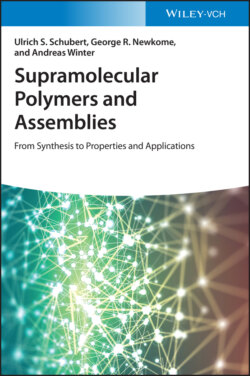Читать книгу Supramolecular Polymers and Assemblies - Andreas Winter - Страница 9
Preface
ОглавлениеThere is a long history of the use of both naturally occurring polymers and synthetic polymers culminating in our current deep understanding of supramolecular polymers. In the 1500s, British explorers discovered that Mayan children were playing with rubber balls made from local trees and, 150 years ago, the first synthetic polymer was made by Wesley Hyatt. He treated cellulose with camphor to create a synthetic ivory to meet the needs of the then rapidly growing billiard enterprise. This year, synthetic polymer chemistry celebrates its 100th birthday, marked by when Hermann Staudinger published his then highly controversial proposal that polymers are indeed long chains, which are formed from repeating molecular units by covalent bonds. Throughout the last century, polymer chemistry has evolved tremendously not only with respect to the design and synthesis of tailor‐made architectures but also concerning the wide range of utilitarian applications to be found in our daily lives. By the 1970s, the use of polymer/plastic surpassed that of steel, aluminum, and copper – combined.
In the 1960s, supramolecular polymers were created in which two or more ions or molecules are held together by non‐covalent interactions, such as ionic/Coulombic, hydrogen‐bonding, and π–π‐stacking interactions as well as metal‐to‐ligand coordination. A wide, diverse group of host–guest (inclusion) complexes was named in this context. Despite their chemically, highly different nature, they offer common characteristics, such as the unique ability to assemble linear polymer chains due to the mostly high directionality of these interactions and, even more importantly, their reversibility of binding. Thus, when incorporated into a polymer backbone, materials are obtained that exhibit properties that cannot be realized by traditional, i.e. covalent polymers.
Today, the fundamental theories that govern supramolecular polymerization reactions are well understood using a broad range of traditional and new analytical techniques, allowing their in‐depth characterization both in solution and in the solid state. This overview of the different types of supramolecular polymers is organized according to the non‐covalent interactions from which they have been assembled. In each case, the fundamental aspects as well as examples of supramolecular polymers with respect to their synthesis, properties, and potential applications are summarized. We have attempted to cover each field as detailed as possible in order to assist future researchers in this rapidly expanding arena. Future research on supramolecular polymers will continue to develop and thus, in part, replace traditional historic polymeric materials. It will be important to also make forthcoming materials more biodegradable, lighter, safer, and yet still inexpensive. Hopefully, this overview will help researchers open new pathways to supramolecular systems.
June 2020
Jena & Jupiter
